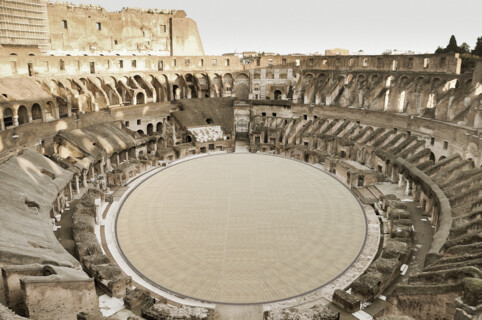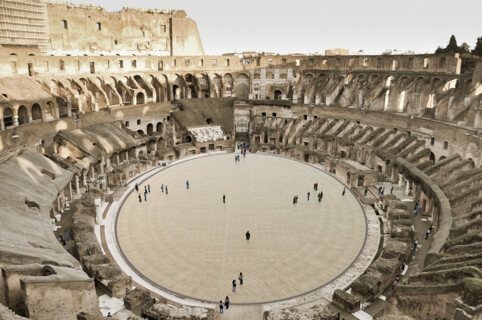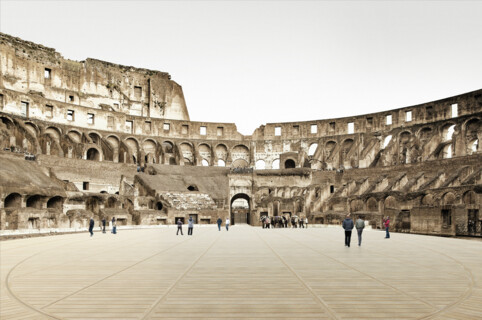- wa-ID
- wa-2031775
- Tag der Veröffentlichung
- 01.06.2021
- Aktualisiert am
- 01.06.2021
- Verfahrensart
- Einladungswettbewerb
- Teilnehmer
- Ingenieur*innen, Architekt*innen etc
- Beteiligung
- 10 Arbeiten
- Auslober
-
Ministry of Culture of the Italian Government
Parco Archeologico del Colosseo - Bekanntgabe
- 28.05.2021
Press release by the Ministry of Culture and Parco Archeologico del Colosseo, 28 May 2021
The winning project in the competition for the Colosseum's New Arena Floor, a competition promoted by the Ministry of Culture of the Italian Government and Parco Archeologico del Colosseo, proposes a solution of great formal simplicity. Underlying is a deep knowledge of the monument, of the needs related to its conservation and also the desire to offer visitors a wider and more complete spatial experience.
The leading principles behind the project are the protection and conservation of the pre-existing archaeological structure. These principles will be applied in terms of both the structure and appearance of the project, ensuring that it will integrate seamlessly with the monument. This integration will be achieved by meeting all the existing archaeological, structural, architectural, hydraulic, conservation and management requirements.
The new structure will cover the entire floor and will be able to be remotely opened in a variety of configurations. This system will be monitored in conjunction with environmental conditions to optimise the opening and closing cycles to carefully conserve the underground structures. The floor will be built at the same level of the original wooden floor, which was constructed during the Flavian Period. This will allow the new floor to connect perfectly with the original structure along the perimeter, providing access to the “service corridor” and to Porta Triumphalis and Porta Libitinaria.
The new floor will be constructed with extremely light and high-performance materials so that the new structure, with insulated dynamic components, can be supported by underground masonry structures. The distribution of the load will be optimised by using the original foundations, which will also eliminate all barriers to the visitors’ view of the archaeological structure. These materials also allow the use of a particularly thin structural section which will separate the new structures from the archaeological finds.
The support system will be constructed by installing many layers that will chemically and physically insulate the underground masonry structures and make them resistant to horizontal seismic stress and dynamic forces generated by visitors walking on the arena floor.
The integrated, multifunction and technologically advanced load-bearing section, will have structural and system support functions.
This section will be made from stainless steel and its internal structure will enable the installation of bollards to protect the retractable floor, illumination for the underground areas, an apparatus for the removal of biodeteriorating organisms and an apparatus for the collection and recovery of rainwater to be used for the public restrooms (before the Covid pandemic, the Colosseum welcomed over 20,000 people a day).
Therefore, when completely closed, not only will the floor protect the archaeological structures below against adverse weather conditions, but it will also help reduce the water load of all the underground areas. The surface of the floor will be realised using rotatable and movable panels of a light and resistant composite material made from carbon fibre and Termanto.
All the structures will be covered with Accoya wood. This material is produced using a process that modifies the structure of the wood, allowing the timber to be sourced from sustainable plantations instead of native forests. This process, which uses acetylation, creates a high-performance material that requires little maintenance and that is resistant to bacteria, xylophagous insects and deterioration caused by adverse weather conditions.
The integrated sections, which will be at the same level as the extrados of the new arena floor, will be stylistically similar to the underlying archaeological structures to create a seamless integration between the underground structures and the Colosseum cavea, also when the floor is completely closed.
With its various configurations, created by opening and moving the slats, the new floor will gradually reveal the underground structures to the visitors demonstrating their detailed structure. In this way, ‘it will be possible to understand the complex functional nature of the underground areas and their interaction with what used to happen above.’
The slats will be moved without interrupting the visit or hiding any part of the archaeological structures. The activation of such mechanism during the visit to the underground areas will ensure new and outstanding views, as well as amplify the effect of natural light and the magnificence of the Colosseum.
The movable slats can be opened separately in order to perfectly manage conservation activities, access to the areas and visitors’ experience.
All the structures will be completely removable to carry out maintenance work and will not affect the original structures to ensure that the project is entirely reversible and the original conditions can be restored.
The movement mechanism will be automated, remote-controlled and able to be activated several times a day in a variety of configurations.
The microclimate will be maintained by constantly monitoring the temperature and humidity of the underground areas to ensure the most suitable conditions for the conservation of the remains/structures.
Any change in the microclimate will be managed through a system of alerts activated by the monitoring system, which enables personnel to check or restore the optimal conditions of the parametres: surface area opened and/or closed, duration of the different configurations (opened, closed, intermediate), direct exposure to the sun, air velocity and humidity level.
If necessary, it will be possible to carry out air renewal of the whole area below the new floor in just 30 minutes by activating mechanically controlled ventilation units along the perimeter of the underground area, thus allowing factors such as temperature and humidity to be regulated. The ventilation system will be installed in 24 of the 32 perimetral recesses that are symmetrically located along the east-west axis. All the equipment will be installed using support structures that will only sit against the walls without affecting the archaeological masonry, thus making their installation completely reversible.
The fans will be equipped with EC electric motors with variable speeds. They will be set individually based on the speed required in each area. The speed will be controlled through the monitoring system to ensure that the air generated will not damage the archaeological areas. Electricity consumption will be optimised through the automatic deactivation of individual fans in the areas where parts of the floor are temporarily opened or where slats are in a vertical position (opened). The use of artificial intelligence is included in the project for the management of the monitoring system. This technology will allow the collection of data related to microclimate, surface lighting, quantity of water in the underground channel and structural behaviour of the elements. In addition to collecting microclimate parameters, the system will also actively interact with the controlled ventilation system and therefore indirectly interact with the temperature and humidity parametres and the covering system. It will be able to determine the configuration of the arena floor and compare the data of the parameters based on time, duration, quantity and type of opened surface with the ventilation management system.
The new arena floor will therefore allow for better conservation and protection of the archaeological structures in the underground areas, while reconstructing the original appearance of the monument and the complex system of the underground areas. More importantly, the restoration will not affect the profound archaeological, architectural and social value of the Colosseum.
The winning project in the competition for the Colosseum's New Arena Floor, a competition promoted by the Ministry of Culture of the Italian Government and Parco Archeologico del Colosseo, proposes a solution of great formal simplicity. Underlying is a deep knowledge of the monument, of the needs related to its conservation and also the desire to offer visitors a wider and more complete spatial experience.
The leading principles behind the project are the protection and conservation of the pre-existing archaeological structure. These principles will be applied in terms of both the structure and appearance of the project, ensuring that it will integrate seamlessly with the monument. This integration will be achieved by meeting all the existing archaeological, structural, architectural, hydraulic, conservation and management requirements.
The new structure will cover the entire floor and will be able to be remotely opened in a variety of configurations. This system will be monitored in conjunction with environmental conditions to optimise the opening and closing cycles to carefully conserve the underground structures. The floor will be built at the same level of the original wooden floor, which was constructed during the Flavian Period. This will allow the new floor to connect perfectly with the original structure along the perimeter, providing access to the “service corridor” and to Porta Triumphalis and Porta Libitinaria.
The new floor will be constructed with extremely light and high-performance materials so that the new structure, with insulated dynamic components, can be supported by underground masonry structures. The distribution of the load will be optimised by using the original foundations, which will also eliminate all barriers to the visitors’ view of the archaeological structure. These materials also allow the use of a particularly thin structural section which will separate the new structures from the archaeological finds.
The support system will be constructed by installing many layers that will chemically and physically insulate the underground masonry structures and make them resistant to horizontal seismic stress and dynamic forces generated by visitors walking on the arena floor.
The integrated, multifunction and technologically advanced load-bearing section, will have structural and system support functions.
This section will be made from stainless steel and its internal structure will enable the installation of bollards to protect the retractable floor, illumination for the underground areas, an apparatus for the removal of biodeteriorating organisms and an apparatus for the collection and recovery of rainwater to be used for the public restrooms (before the Covid pandemic, the Colosseum welcomed over 20,000 people a day).
Therefore, when completely closed, not only will the floor protect the archaeological structures below against adverse weather conditions, but it will also help reduce the water load of all the underground areas. The surface of the floor will be realised using rotatable and movable panels of a light and resistant composite material made from carbon fibre and Termanto.
All the structures will be covered with Accoya wood. This material is produced using a process that modifies the structure of the wood, allowing the timber to be sourced from sustainable plantations instead of native forests. This process, which uses acetylation, creates a high-performance material that requires little maintenance and that is resistant to bacteria, xylophagous insects and deterioration caused by adverse weather conditions.
The integrated sections, which will be at the same level as the extrados of the new arena floor, will be stylistically similar to the underlying archaeological structures to create a seamless integration between the underground structures and the Colosseum cavea, also when the floor is completely closed.
With its various configurations, created by opening and moving the slats, the new floor will gradually reveal the underground structures to the visitors demonstrating their detailed structure. In this way, ‘it will be possible to understand the complex functional nature of the underground areas and their interaction with what used to happen above.’
The slats will be moved without interrupting the visit or hiding any part of the archaeological structures. The activation of such mechanism during the visit to the underground areas will ensure new and outstanding views, as well as amplify the effect of natural light and the magnificence of the Colosseum.
The movable slats can be opened separately in order to perfectly manage conservation activities, access to the areas and visitors’ experience.
All the structures will be completely removable to carry out maintenance work and will not affect the original structures to ensure that the project is entirely reversible and the original conditions can be restored.
The movement mechanism will be automated, remote-controlled and able to be activated several times a day in a variety of configurations.
The microclimate will be maintained by constantly monitoring the temperature and humidity of the underground areas to ensure the most suitable conditions for the conservation of the remains/structures.
Any change in the microclimate will be managed through a system of alerts activated by the monitoring system, which enables personnel to check or restore the optimal conditions of the parametres: surface area opened and/or closed, duration of the different configurations (opened, closed, intermediate), direct exposure to the sun, air velocity and humidity level.
If necessary, it will be possible to carry out air renewal of the whole area below the new floor in just 30 minutes by activating mechanically controlled ventilation units along the perimeter of the underground area, thus allowing factors such as temperature and humidity to be regulated. The ventilation system will be installed in 24 of the 32 perimetral recesses that are symmetrically located along the east-west axis. All the equipment will be installed using support structures that will only sit against the walls without affecting the archaeological masonry, thus making their installation completely reversible.
The fans will be equipped with EC electric motors with variable speeds. They will be set individually based on the speed required in each area. The speed will be controlled through the monitoring system to ensure that the air generated will not damage the archaeological areas. Electricity consumption will be optimised through the automatic deactivation of individual fans in the areas where parts of the floor are temporarily opened or where slats are in a vertical position (opened). The use of artificial intelligence is included in the project for the management of the monitoring system. This technology will allow the collection of data related to microclimate, surface lighting, quantity of water in the underground channel and structural behaviour of the elements. In addition to collecting microclimate parameters, the system will also actively interact with the controlled ventilation system and therefore indirectly interact with the temperature and humidity parametres and the covering system. It will be able to determine the configuration of the arena floor and compare the data of the parameters based on time, duration, quantity and type of opened surface with the ventilation management system.
The new arena floor will therefore allow for better conservation and protection of the archaeological structures in the underground areas, while reconstructing the original appearance of the monument and the complex system of the underground areas. More importantly, the restoration will not affect the profound archaeological, architectural and social value of the Colosseum.










